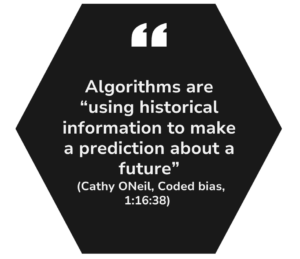Lesson 1: What are algorithms?
Introduction:
- Introduce students to the definition of an algorithm from the Miriam-Webster dictionary: “ Algorithm is a step-by-step procedure for solving a problem or accomplishing some end.”
- Provide an example of a recipe as a step-by-step guide to preparing a meal or solving Rubik’s cube.
Pre-activity
Ask students to share other encounters with step-by-step processes to accomplish a specific goal.
Lecture: Computer algorithms
Computer algorithms use data from the past to make predictions about the future.

Algorithmic systems are a set of instructions that allow digital technologies to perform a specific task, such as providing a recommendation to what video to suggest next (Youtube or Netflix algorithm), what product to show to the consumer (Amazon algorithm), what posts to show to users (Facebook or any other social media algorithms).
However, these systems can only make this prediction if they have enough data. Data has become a commodity or a currency that is extremely precious. Knowing enough data about you can help companies like Google provide targeting advertisement algorithms to maximize their profit.
Activity 1: Understanding the role of data in algorithmic decision-making
Watch the TED talk by Jennifer Golbeck about the role of data shared on social media in creating algorithms to predict specific information.
- What is the role of datafication on social infrastructure and influences?
- Do you think people have control over their own data?
- What are some of the implications of large sets of data being shared freely online by users?

